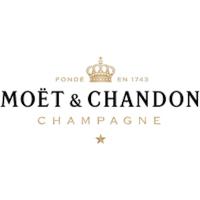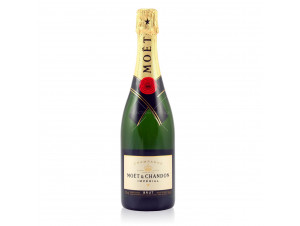You have no items in your shopping cart.
Champagne
Moët & Chandon
(43 customer reviews)
Moët & Chandon prides itself on producing champagne that is brilliantly fruity, with succulent aromas, and that takes the time to age slowly in its cellars. Only teamwork can lead to excellence, and Moët & Chandon makes a point of always highlighting the various people to whom it owes its magnificent results: winemakers, cellar staff, oenological teams... Find out more
 Recommended by
Recommended byParker Wine Advocate - Jancis Robinson - Gault & Millau
-

Shipped in
secured packaging - -15%
- -17%
- -21%
- -21%
- -21%
-

Garantie anti-casse :
Prise en charge totale
The winemaker
Napoléon Bonaparte and Moët & Chandon, linked for eternity
Before becoming Moët & Chandon, the Maison Moët was born in 1743. Its founder, Claude Moët, had already been a wine merchant in Épernay since the early 18th century. He had bought a property frequented by such famous guests as Voltaire, because it belonged to a writer. The mansion sits on a vast plot of land that has been lavishly landscaped over the years. First, a magnificent English garden was laid out, followed by two pavilions for children and an orangery. A pond in the shape of a champagne bottle is dug right in the middle of this enchanting setting.
Napoleon Bonaparte was a regular visitor. He stayed here on several occasions, in the company of Joséphine. In 1792, Jean-Rémy Moët took over the management of the house. He was Claude's grandson. Napoleon even presented him with the Légion d'Honneur he had recently created. At the time, this was the highest honorary decoration and was awarded to all those who could boast of deeds of great value, forged by their own merits.
The tradition of sliding the flat of a saber along the neck of a bottle to open it with a sharp blow is attributed to Napoleon's soldiers, and it would appear to be the Moët champagne with which this practice originated. Sabering a bottle was the symbol for celebrating the emperor's victories and sharing these moments of rejoicing. It was in honor of Emperor Napoleon Bonaparte that the champagne Moët Impérial was named.
Later still, Moët & Chandon would be behind other symbolic gestures that have become French, and even worldwide, traditions. These include smashing a bottle of champagne on the hull of a ship to christen it, or shaking a bottle and spraying it at spectators from a motor-racing victory podium. Moët & Chandon also claims to have invented pyramids of flutes that are filled with champagne so that guests at a vin d'honneur or buffet can help themselves.
After Napoleon, it was the German composer Richard Wagner who stayed at the Moët estate. He found inspiration for his famous opera Tristan and Isolde while playing the eighteen-hole organ in the music salon.
From Moët to Moët & Chandon
Moët became Moët & Chandon in 1833, when Jean-Rémy joined forces with his son-in-law, Pierre-Gabriel Chandon de Briailles. During this period, the champagne house expanded rapidly, first in France, then in Europe and later worldwide. In 1962, Moët & Chandon acquired one of its competitors Ruinart, then, in 1970, the Maison de champagne Mercier. In 1973, Moët & Chandon innovates by investing in an estate in California. It thus launched the Domaine Chandon, in the Napa Valley.
It then continues its investments by spilling over into the luxury sector with the 1971 acquisition of Christian Dior perfumes, and by moving closer to cognac from the Hennessy house. In 1987, Moët Hennessy merged with leather goods manufacturer Louis Vuitton to become part of the LVMH group.
Moët & Chandon expertise
Moët & Chandon is keen to preserve its know-how, which blends ancestral techniques handed down from generation to generation with modern, much more technical methods. Nature and the vineyard remain immutably at the heart of the producer's concerns, and preserving the environment is paramount in his production choices. Progress in viticulture benefits the terroir and everything is done to protect it.
The result can be found in every bottle of Moët & Chandon: an exceptional, balanced and harmonious champagne, recognized the world over. The container is also showcased, with Swarovski crystal-encrusted bottles in particular, which have become must-haves
The house never ceases to innovate, creating exclusive, personalized editions. Its latest find is Moët Ice Impérial. This is the first champagne designed to be enjoyed with ice cubes.
Moët & Chandon champagnes
Moët Impérial
The Moët Impérial is the house's emblematic cuvée since 1869, the centenary of the birth of Napoleon Bonaparte who inspired this appellation. It represents the blending of the diversity of grape varieties, with all the richness of the Champagne region's terroirs.Generous and complex, Moët Impérial astonishes with its superb fruity and savory palate. It results from the blending of over 200 crus, within which we find the three Champagne grape varieties, roughly balanced. The pinot noir and pinot meunier each account for between 30 and 40%, complemented by the chardonnay between 20 and 30%.
The addition of 20-30% reserve wines enhances its complexity and maturity, but also its consistency.
Moët Impérial boasts a golden yellow color, adorned by magnificent green highlights. Its mouth is generous and subtle, tasty and fresh. As for its nose, it overflows with white-fleshed fruits, such as white peach, pear and apple, complemented by citrus, such as lemon, as well as floral nuances of lime blossom.
Moët Rosé Impérial
The Moët Rosé Impérial offers a radiant floral color for an intense fruit flavor. It gathers the qualities of Champagne's three grape varieties to form the most delicious of nectars.The pinot noir, present at 40-50%, brings all its intensity. The pinot meunier comes next, with 40-50% to provide its magnificent fruitiness. The blend is completed by 10-20% chardonnay, which provides delicate finesse.
With its radiant color, Moët Rosé Impérial is adorned with violet highlights that evoke its bouquet filled with red fruits, such as strawberries, redcurrants and raspberries. There are also floral hints of hawthorn and rose.
The mouth of Moët Rosé Impérial is intense and round, juicy and fleshy to start with, ending with a subtle mint perfume.

22 wines available
between 16.7 € and 450 €
between 16.7 € and 450 €

390 wine's scans
on Twil application
on Twil application

Best rated wines on Twil :
You might like Voir tous les vins de la région
- -26%
- -27%
- -26%









































 TWIL - Achat de Vin
TWIL - Achat de Vin


